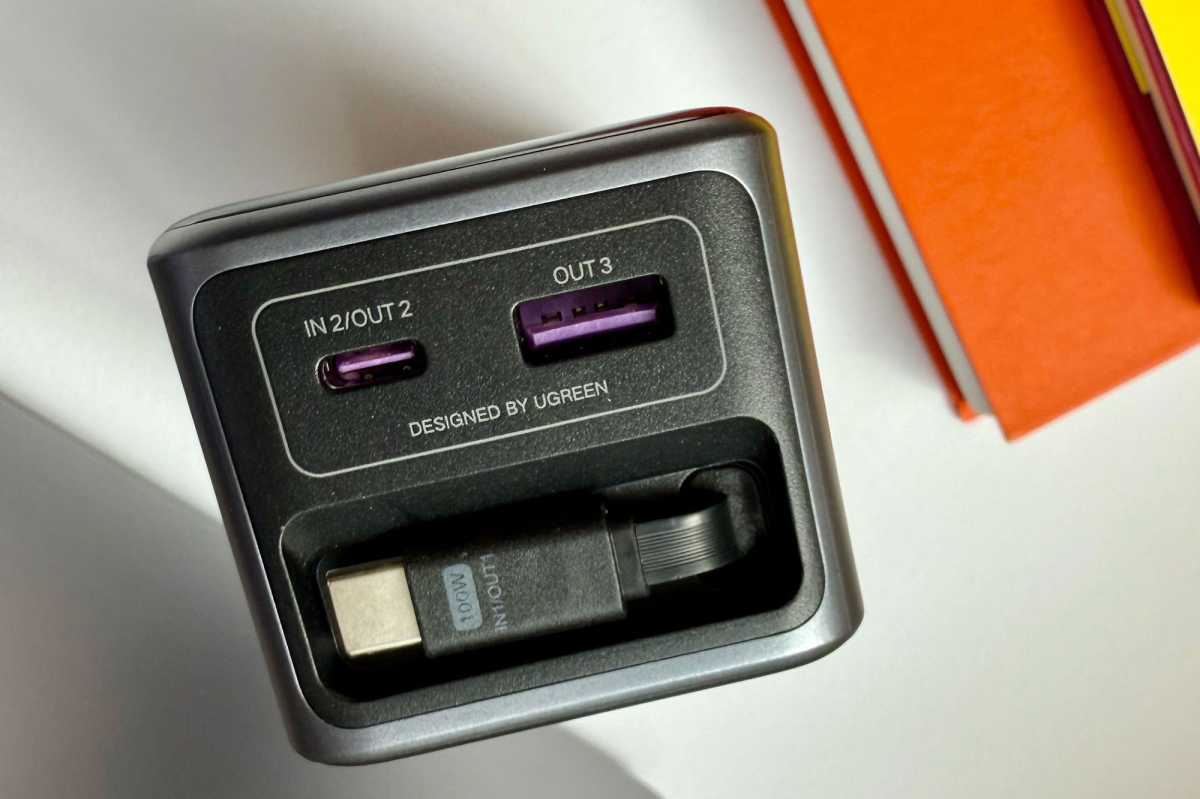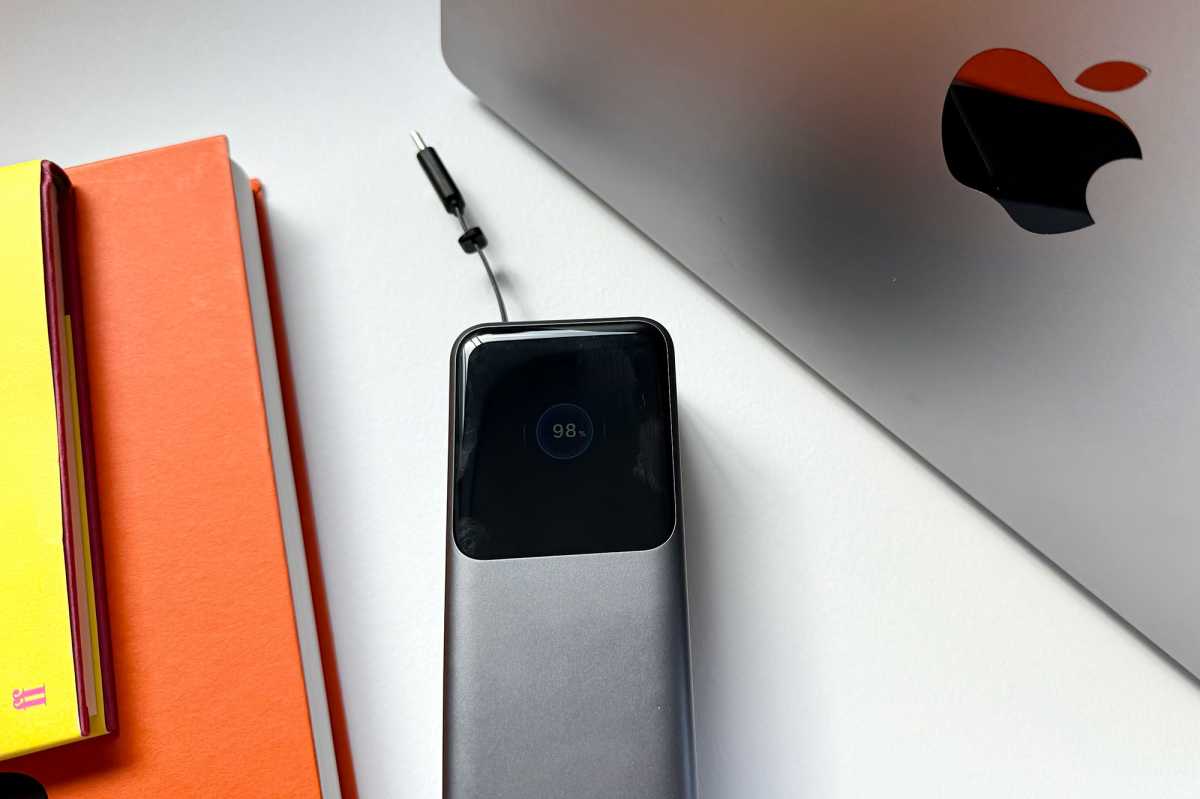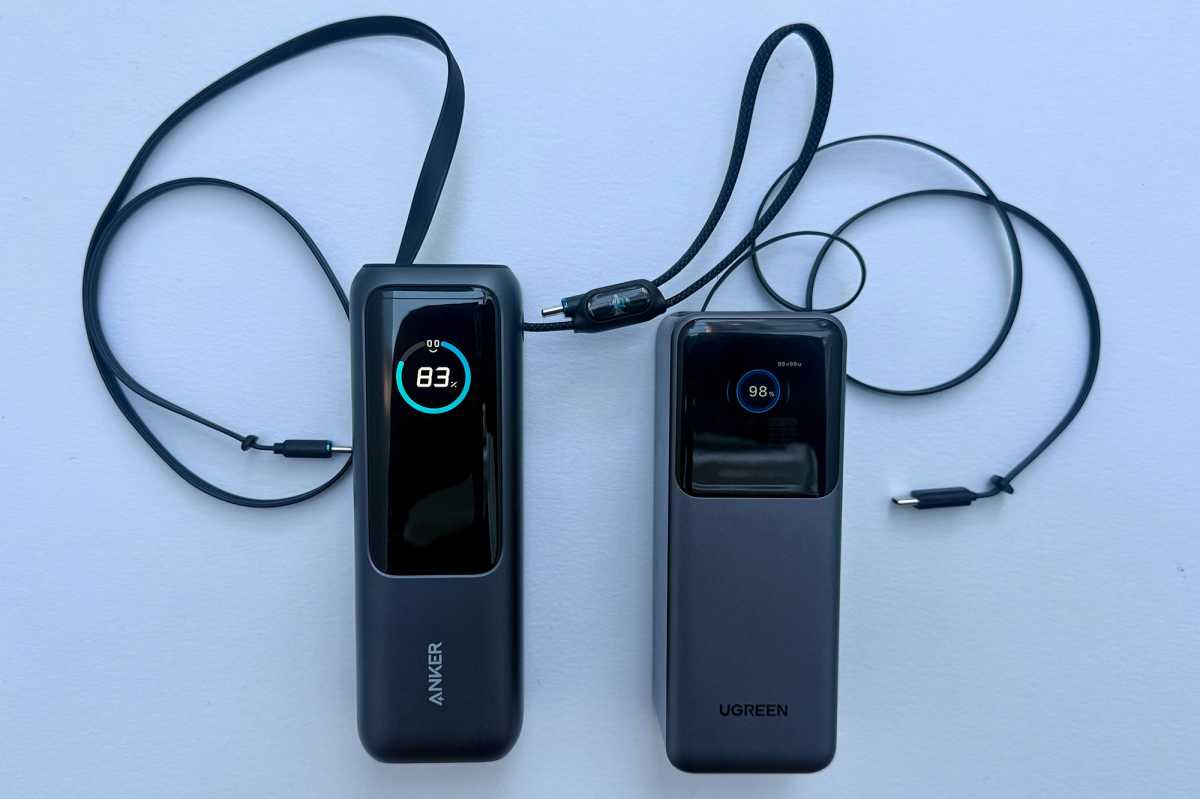
At a glance
Expert’s Rating
Pros
- Large battery capacity
- Built-in retractable USB-C cable
- 100W USB-C in and out
- 165W max
Cons
- Do we still need USB-A?
Our Verdict
This compact, lightweight laptop power bank has a convenient and retractable USB-C cable built-in, and boasts fast outputs and an equally speedy input.
Price When Reviewed
This value will show the geolocated pricing text for product undefined
Best Pricing Today
Price When Reviewed
$99.99
Best Prices Today: Ugreen Nexode Power Bank 20000mAh 165W with Retractable USB-C Cable
The Ugreen Nexode Power Bank 20000mAh 165W with Retractable USB-C Cable tells you nearly everything you need to know about it in just its name.
It’s a compact 20K laptop battery pack that can deliver a total of 165W of power, including 100W from its extremely convenient built-in USB-C cable.
You can buy higher capacity portable laptop power banks and even units with two integrated USB-C cables, but the Ugreen Nexode 20K USB-C Cable power bank is a solid performer that might be everything you need on the road with your laptop and other devices.
Power bank tech specs
- Battery capacity: 20000mAh (72Wh)
- Fastest Power Output: 100W
- Total Power Output: 165W
- Power Input: 100W
- USB ports: 1x USB-C cable (100W PD 3.0); 1x USB-C port (100W PD 3.0); 1x USB-A (33W)
- Dimensions: 5.7 x 2.1 x 2 inches (14.6 x 5.4 x 5cm)
- Weight: 11.8oz (335g)

Simon Jary
Power and performance
The Ugreen Nexode 20K USB-C Cable power bank is powerful enough to keep any of Apple’s MacBooks charged, as well as its phones and other products even at the same time—indeed it’s compatible with just about any USB-C-powered device.
With its 100W output—from either its built-in cable or the USB-C port—it can fast-charge the 14-inch MacBook Pro and MacBook Airs. It will charge a 16-inch MacBook Pro but not “fast” as that requires a 140W PD 3.1 charger. If you are not thrashing the 16-inch with a bevy of processor-ripping apps, even the top-end MacBook won’t run out of juice before the power bank has given its all.
If you do need a power bank that can fast charge at PD 3.1, check out of roundup of the best MacBook power banks for all the options.
The Nexode’s 72Wh battery is enough to fully refill the 13-inch Air (54Wh) and close for a 15-inch Air (66.5Wh).
Unless under ideal (theoretical) conditions, not every milliamp of a power bank’s capacity will find its way into the connected laptop’s battery because in real-world use, energy gets lost during the charging process for several reasons: the laptop is using some power while charging, plus power conversion efficiency and heat take their toll.
We tested the Ugreen Nexode power bank with a 14-inch M2 MacBook Pro that is rated at around the same watt hours (between 70Wh and 72Wh) and it managed to power it up to nearly 80%, which should be enough to get you to the next available static power socket or sleep time on a long-haul flight.
See our list of MacBook battery capacities for more details on the whole range of Apple laptops.
At 72Wh it is within TSA, CAA and EASA airline limits for carry-on.
The power bank is charged itself at up to 100W, which means you can refill the battery pack as fast as you can empty it—great for a fast turnover at the airport between connecting flights.

Simon Jary
Power distribution
You can charge three devices simultaneously, but the wattage isn’t evenly distributed. Charging two devices, the integrated USB-C cable can output 100W and the USB-C port 65W—hence the max power output being the stated 165W. That’s a great solution if you are recharging two laptops at the same time.
Use one USB-C and the USB-A and you can achieve 100W + 33W, as you’d expect
However, when using all three ports the total power output is reduced to 100W for the cable and just 20W shared between the USB-C and USB-A ports.
I am starting to question why modern charging devices still bother with a USB-A port now that just about everything can be charged with a cable that has USB-C on at least one end. You can’t fast-charge an Apple device with USB-A at the charging point end, and I can’t think of an Apple device that still requires a USB-A cable for charging.
There certainly are some devices that frustratingly still ship with a charging cable with the old rectangular Type A connector—stand up in shame, Fitbit. But clearly the days of USB-A’s involvement in charging are numbered.
I’d have been happier with another USB-C instead of the USB-A port. I suppose in time we’ll see fewer power banks with USB-A but clearly manufacturers still see the demand out there for the legacy power connection.

Simon Jary
Design
The Nexode conforms to the mainstream laptop power bank pillar shape and space gray coloring.
The built-in USB-C cable is 2.1 foot (65cm) long and nests discreetly at the top of the unit alongside the two ports.
A large informative display shows the remaining percentage of power bank battery capacity, output and input wattage, plus battery health and temperature.
There are rubber feet down the long side opposite the display so it can rest securely when laid flat.
It looks good and works well but a little more imagination would be nice: check out our INIU Cougar P62-E1 20000mAh (65W) Power Bank review for an example of a battery pack with more design flair.
Alternatives
Ugreen has another similar-looking 20K Nexode Power Bank that is cheaper but lacks the built-in USB-C cable, has its second USB-C port limited to 30W and maxes out at 130W. We think paying the extra for the 165W Cable version is a better deal.
The 200W (max) Anker Prime 20000mAh Power Bank offers two USB-C (100W PD 3.0) and one USB-A (65W PD 3.0). Again, no cable but that extra total output might tempt you. Having a 65W USB-A seems a little pointless given my above thoughts on USB-A. It is also available in a glitzy Champagne color for some extra glamor.

Simon Jary
If you want the convenience of a built-in cable, the Anker 25K Power Bank With Cables, as the name suggests, has more than one. One cable is retractable (and slightly longer than the Ugreen’s) and the other is fixed and can be used as a carrying strap when not in use. Each has a 100W output as does the USB-C port, with a 33W USB-A port also in the mix. Like the Ugreen, 165W can only be supplied by two devices; with three and four devices, the maximum output is limited to 133W.
The Anker power bank with cables offers more than the Ugreen in terms of outputs and battery capacity (25K vs 20K) but its price is higher and it’s taller (6.2 inches vs 5.7 inches) and noticeably heavier (21oz vs 12oz), while the maximum power output is the same.
Another laptop power bank with built-in cable option is the Baseus EnerCore CR11, which offers a different shape but lacks the Nexode’s power with just 67W max.
Price
The Ugreen Nexode Power Bank 20000mAh 165W with Retractable USB-C Cable is list-priced at $99.99/£79.99 but we’ve seen it discounted to $75—check out our live pricing comparisons with this review. The non-cabled Ugreen Nexode 20K power bank is listed at $89.99, but is not as powerful as the Nexode 20K with Cable.
The cheapest 20000mAh power bank we have tested is the $35 Cuktech CP253L 20000mAh Power Bank that offers three outputs but no built-in cable and is limited to 55W max—fine for the MacBook Air but not a wise choice for a Pro unless you really are saving the pennies.
Considering the cable plus higher power, the Nexode on test here is a clear winner. Its closest rival is that dual cabled but larger $119 Anker 25K Power Bank.
Should I buy the Ugreen Nexode Power Bank 20000mAh 165W with Retractable USB-C Cable?
This is a compact and reasonably lightweight laptop power bank with a convenient and retractable USB-C cable built-in, boasting fast outputs and an equally speedy input. It performed well in our MacBook-charging tests and can be recommended for even the higher end Pro MacBooks.






